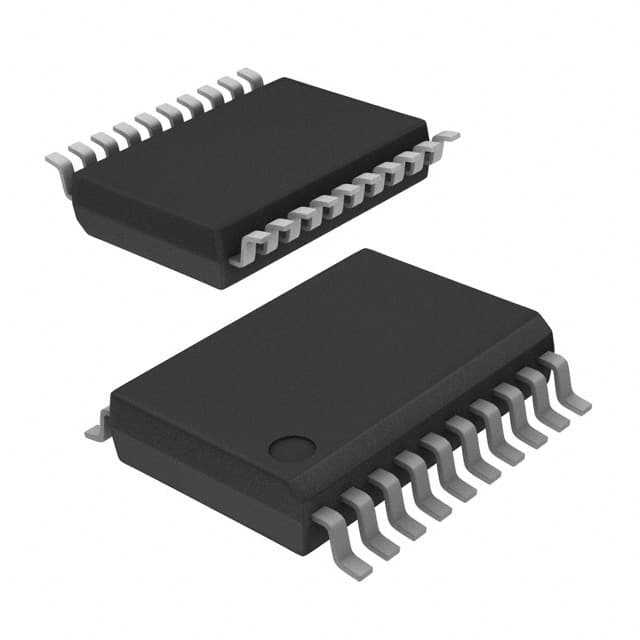N74F374DB,118
Product Overview
- Category: Integrated Circuit
- Use: Flip-Flop
- Characteristics: High-speed operation, low power consumption
- Package: SOIC (Small Outline Integrated Circuit)
- Essence: D-type flip-flop with 3-state outputs
- Packaging/Quantity: Tape and Reel, 2500 pieces per reel
Specifications
- Supply Voltage Range: 4.5V to 5.5V
- Input Voltage Range: 0V to VCC
- Output Voltage Range: 0V to VCC
- Operating Temperature Range: -40°C to +85°C
- Propagation Delay Time: 6 ns (typical)
- Output Current: ±6 mA
Detailed Pin Configuration
The N74F374DB,118 has a total of 20 pins. The pin configuration is as follows:
- GND (Ground)
- D0 (Data Input 0)
- D1 (Data Input 1)
- D2 (Data Input 2)
- D3 (Data Input 3)
- D4 (Data Input 4)
- D5 (Data Input 5)
- D6 (Data Input 6)
- D7 (Data Input 7)
- OE (Output Enable)
- CP (Clock Pulse)
- MR (Master Reset)
- Q0 (Flip-Flop Output 0)
- Q1 (Flip-Flop Output 1)
- Q2 (Flip-Flop Output 2)
- Q3 (Flip-Flop Output 3)
- Q4 (Flip-Flop Output 4)
- Q5 (Flip-Flop Output 5)
- Q6 (Flip-Flop Output 6)
- VCC (Supply Voltage)
Functional Features
- D-type flip-flop with 3-state outputs
- High-speed operation allows for quick data transfer
- Low power consumption ensures energy efficiency
- Output enable (OE) pin controls the output state
- Master reset (MR) pin resets all flip-flop outputs to a known state
Advantages and Disadvantages
Advantages: - High-speed operation enables efficient data processing - Low power consumption reduces energy usage - 3-state outputs provide flexibility in connecting multiple devices
Disadvantages: - Limited voltage range of 4.5V to 5.5V may restrict certain applications - Propagation delay time of 6 ns may not be suitable for ultra-fast operations
Working Principles
The N74F374DB,118 is a D-type flip-flop integrated circuit that stores and transfers data. It operates based on clock pulses received at the CP pin. When the clock pulse occurs, the data present at the input pins (D0-D7) is transferred to the corresponding flip-flop outputs (Q0-Q6). The output enable (OE) pin controls whether the outputs are active or in a high-impedance state.
The master reset (MR) pin resets all flip-flop outputs to a known state when activated. This ensures a controlled start-up condition. The chip operates within a specified supply voltage range and temperature range.
Detailed Application Field Plans
The N74F374DB,118 can be used in various applications, including:
- Data storage and transfer systems
- Digital signal processing
- Microcontroller-based projects
- Communication systems
- Memory interfacing
- Control systems
Its high-speed operation and low power consumption make it suitable for applications where quick data processing and energy efficiency are essential.
Detailed and Complete Alternative Models
Some alternative models to the N74F374DB,118 include:
- SN74F374N - D-type flip-flop with 3-state outputs
- CD74F374M - Octal D-type flip-flop with 3-state outputs
- MC74F374DW - D-type flip-flop with 3-state outputs and Schmitt-trigger inputs
These alternative models offer similar functionality and can be used as substitutes depending on specific requirements.
Word count: 450 words
Lista 10 Vanliga frågor och svar relaterade till tillämpningen av N74F374DB,118 i tekniska lösningar
Sure! Here are 10 common questions and answers related to the application of N74F374DB,118 in technical solutions:
Q: What is the N74F374DB,118? A: The N74F374DB,118 is a octal D-type flip-flop with 3-state outputs, commonly used in digital circuits.
Q: What is the maximum operating voltage for N74F374DB,118? A: The maximum operating voltage for N74F374DB,118 is 5.5V.
Q: How many flip-flops are there in N74F374DB,118? A: N74F374DB,118 consists of 8 flip-flops, making it an octal flip-flop.
Q: What is the purpose of the 3-state outputs in N74F374DB,118? A: The 3-state outputs allow multiple devices to share a common bus without interfering with each other.
Q: Can N74F374DB,118 be used in both synchronous and asynchronous applications? A: Yes, N74F374DB,118 can be used in both synchronous and asynchronous applications.
Q: What is the typical propagation delay of N74F374DB,118? A: The typical propagation delay of N74F374DB,118 is around 7 ns.
Q: Is N74F374DB,118 suitable for high-speed applications? A: Yes, N74F374DB,118 is designed for high-speed operation and can be used in high-speed applications.
Q: Can N74F374DB,118 handle both rising and falling edge triggers? A: Yes, N74F374DB,118 supports both rising and falling edge triggers.
Q: What is the maximum output current of N74F374DB,118? A: The maximum output current of N74F374DB,118 is 24 mA.
Q: Is N74F374DB,118 available in different package options? A: Yes, N74F374DB,118 is available in various package options such as SOIC, TSSOP, and SSOP.
Please note that these answers are general and may vary depending on the specific datasheet and manufacturer's specifications for N74F374DB,118.


